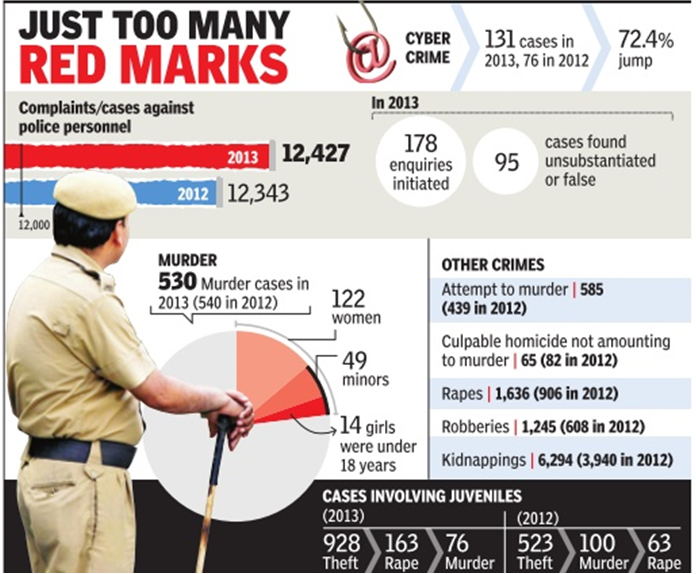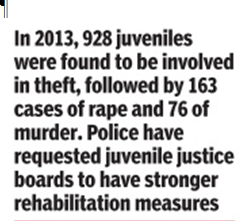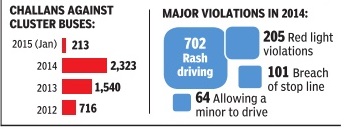Delhi: Crime
(→2015) |
|||
| Line 1: | Line 1: | ||
| + | [[File: ‘Snatchings’ in Delhi, 2011-15.jpg|‘Snatchings’ in Delhi: 2011-15; Graphic courtesy: [http://epaperbeta.timesofindia.com/Gallery.aspx?id=05_06_2016_004_020_012&type=P&artUrl=Shot-at-cop-takes-down-robber-05062016004020&eid=31808 ''The Times of India''], June 5, 2016|frame|500px]] | ||
[[File: 2008-14, Children who went missing in Delhi, and those who remained untraced.jpg|2008-14, Children who went missing in Delhi, and those who remained untraced; Graphic courtesy: [http://epaperbeta.timesofindia.com/Gallery.aspx?id=16_09_2015_006_018_011&type=P&artUrl=Runaway-boy-returns-to-Jkhand-16092015006018&eid=31808 ''The Times of India''], September 16, 2015|frame|500px]] | [[File: 2008-14, Children who went missing in Delhi, and those who remained untraced.jpg|2008-14, Children who went missing in Delhi, and those who remained untraced; Graphic courtesy: [http://epaperbeta.timesofindia.com/Gallery.aspx?id=16_09_2015_006_018_011&type=P&artUrl=Runaway-boy-returns-to-Jkhand-16092015006018&eid=31808 ''The Times of India''], September 16, 2015|frame|500px]] | ||
{| class="wikitable" | {| class="wikitable" | ||
| Line 8: | Line 9: | ||
[[Category:India |C]] | [[Category:India |C]] | ||
| − | [[Category: Places |D ]] | + | [[Category:Places |D ]] |
| − | [[Category: Crime |D ]] | + | [[Category:Crime |D ]] |
=2013= | =2013= | ||
Revision as of 20:56, 6 August 2016
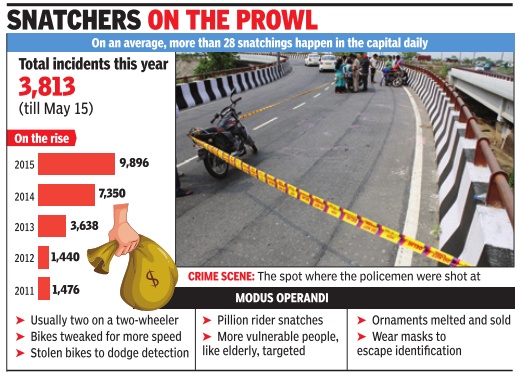

This is a collection of articles archived for the excellence of their content. |
Contents |
2013
Juveniles, cyber crooks keep police on toes
Raj Shekhar & Somreet Bhattacharya New Delhi:
TNN
The Times of India Jul 02 2014
More Minors Involved In Rapes; Most Offenders Fall Under 16-18 Age Group
Cases involving juvenile offenders have increased by 28%--2,140 minors were tracked down in 1,590 criminal cases registered in 2013. In 2012, the figure was 1,541 against 523 cases.
In 2013, most juveniles were charged with theft as has been the trend. Unlike 2012, they were found to be involved in more rape cases than murders.
Of the 2,140 juveniles apprehended, 2,087 were found to be involved in cognizable offences; 697 were sent to home after admonition and advice, while 301 were released on probation. As many as 692 juveniles were sent to special homes, 17 faced fines and 149 were acquitted; 267 cases are pending.
Among those apprehended, 821 had dropped out of school at the higher secondary level; 599 were primary school dropouts, and 421 were illiterate.
As many as 1,774 were found to be also living with their parents, while 69 were homeless; 849 children were found to have a family income below Rs 25,000 a year, while 714 belonged to the in come group of Rs 25,001-Rs 50,000.
In 2013, juveniles were involved in 928 cases of theft, burglary or snatching, followed by 163 cases of rape and 76 murder cases.
In 2012, the figure was 1,144, of which 523 were involved in theft, followed by100 cases of murder and 63 of rape.
The NCRB statistics reinforce the need to bring down the juvenile age limit to 16, which Delhi Police has been demanding since the Nirbhaya case.
Out of 2,087 apprehended juveniles, 1,148 were in the age-group of 16-18. In 2012, this figure was 860. Nationally, 66.8% of the juveniles are in this age group.
Among the apprehended juveniles, 875 were boys between 12 and 16; the figure was 617 for 2012. The cops apprehended 23 girls of different ages for various crimes. In 2013 and 2012, juveniles were found to be involved in rapes, gruesome murders of elderly people and robberies.
Around a dozen escapes from correctional homes were reported in the last two years.
Delhi Police has requested juvenile justice boards and child welfare committees to put in place stronger rehabilitation programmes at correctional homes so that minors can be weaned away from criminal activities.
Senior police officers made this request to Child Welfare Committee officials during a sensitization programme.
In a programme conducted by the Delhi police earlier this year, the principal judge JJB-II, Suchi Laler, had even asked the counsellors to find out the reason behind children resorting to crime and had called for educating the parents too.
Crime in Delhi: 2014
Jan 03 2015
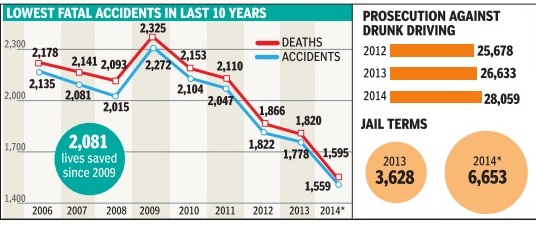

Roads are safer: 10year low in accidents
Somreet Bhattacharya Despite an increase in the number of vehicles, 2014 witnessed the lowest number of accidents in the past 10 years. In all, 1,595 deaths were reported in 1,559 accidents. During the previous year, 1,820 people had died in 1,778 accidents. The police have attributed the decrease to steps like installing speedchecking equipment and conducting intensive drives against drunken driving and speeding which cause the maximum number of accidents in the city .Delhi Police commissioner B S Bassi blamed multimodal traffic, rapid unplanned commercialization along roads and an indifferent attitude towards road safety for the high rate of accidents. A special initiative was taken to identify high-speed corridors where traffic violations are rampant leading to deaths. The traffic police also formed a committee to analyse the cause, time and nature of every road accident that had taken place in 2014 and took corrective measures.
Out of the 7 lakh prosecutions by the traffic police last year, 1,23,676 vehicles were prosecuted for speeding as against 29,045 in 2013. The cops also introduced 11 high-speed interceptors that were deployed in areas where drivers tend to speed. A fleet of 50 highway patrol vehicles was deployed on the national highways passing through the city .
The traffic police cracked down on heavy vehicles plying without a rear under-run protection device, a bar that prevents smaller vehicles from slipping under the bigger one during a crash. This prevents fatalities and is a mandatory feature. Till mid-December, 21,514 heavy vehicles had been prosecuted. Delhi Police might also push for taking stricter action against heavy vehicle owners failing to comply with the prescribed standards. They booked 1,90,000 heavy vehicles for dangerous driving and impounded 1049 of them for failing to observe traffic norms. The cops also prosecuted 6653 drunk drivers this year which is nearly 50% more than 2013. Out of these, 17 were given a jail term ranging between one and three days, 21 four and five days, seven six and nine days and six for 10 days. The cops also counselled 38,224 traffic rule violators after challaning them.
Drives were conducted against e-rickshaws which had been banned from plying in the city and 7038 were imponded.
Measures were also taken to increase traffic police presence past midnight resulting in a decrease in fatalities. The duty hours of the personnel were extended to 4am to carry out special drives and night checking.
The traffic cops issued all challans through the e-challan system which allows them to maintain a database of traffic violators. Repeat offenders were targeted and 707 licences cancelled for drunk driving. Action was taken on the basis of complaints found on the traffic police facebook page.
2014
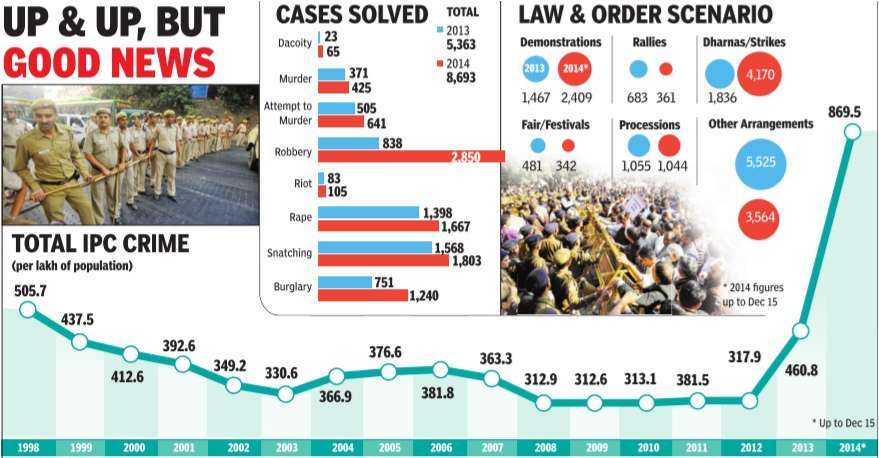
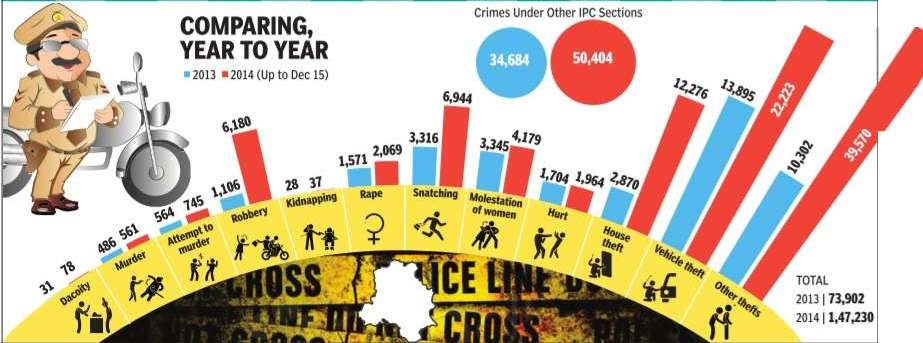
Crime against women: Delhi, 2014
Jan 03 2015
Nitisha Kashyap
The year 2014 not only saw a considerable increase in the registration of rape cases, but also a majority of the cases being solved well in time. Be it the Danish woman's gang rape case with which the year started or the cab rape with which the year ended, the accused were arrested within 48 hours. Cops said hesitation in getting a rape case registered has come down. Survivors are also helping police with important details like photos or a description of the accused.
Police chief BS Bassi said 78% cases were solved within a fortnight. Around 61% rapes and 62% molestation cases were worked out within a week. Cops said the accused were known to the victims in 96% rape cases. In approximately 72% rapes, the crime was committed by a relative or a friend, while in 21% the accused was a neighbour.Cases of rape by employers or co-workers constituted 3% of the total.
Bassi has proposed compulsory self-defence training in schools for girls. For safety of women travelling in public transport, police has introduced Special Squad for Women Protection. This squad travels in civvies in buses to ensure no girl is being harassed.
Last year, till December 15, 2,069 cases of rape were reported--a 31.7% increase over 2013 when 1,571 incidents were registered. Police claim to have solved 80.57% (1,667 of 2,069) of them. The number of molestation cases went up to 4,179, an increase of 24.93%, against 3,345 in 2013. Police claim to have solved 67.17% (2,807 of 4,179).
Currently , there are 859 pa trol vans to assist women travelling late or stranded. Police have also deployed motorcycle patrols, emergency response vehicles for women's security . Police officials are also posted outside girls' schools and colleges.
2014: Rapes in Delhi
The Times of India, Aug 20 2015
Crime shoots up, women bear brunt
Somreet Bhattacharya
460 more rape cases in 2014 than in 2013
The year 2014 started with the gang rape of a Danish tourist and ended with the rape of a woman executive by the driver of her app-based taxi. All through the year, there were 2,094 other rapes--an alarming increase of 28.1% over 2013, NCRB data shows. In absolute terms, the number of rape cases increased by 460. Overall, complaints of crime against women increased by 18.4%, from 12,888 in 2013 to 15,265 in 2014. Police say cases were registered on almost all the complaints last year. Rape cases were registered on 2,096 of the 2,102 complaints and 1,667 cases were solved.
Young girls and women aged below 30 years were tar gets in about 87% of rape cases. Nearly half of the survivors were aged below 18 while 71 were aged below six.The number of minors raped in the city increased sharply from 757 in 2013 to 1,008 in 2014. Police claimed the accused were known to the survivors in 1,083 cases.
Molestation cases also shot up by 24.9%, from 3,345 in 2013 to 4,179 in 2014. Police claimed to have solved 67% of the molestation cases. Besides these, there were 4,227 cases of women and minor girls getting abducted.
While crime against women shot up, police claimed to have arrested 90% of the accused in rape cases, often within 48 hours.
The city police have 1,000 patrol vans and the staff has instructions to assist women travelling late or stranded on the way . Police also use motorcycle patrols and emergency response vehicles for women's safety . Personnel are positioned outside girls' schools and colleges and Delhi Police has proposed compulsory self-defence training in schools for girls.
Cops in plainclothes have started travelling in buses to catch youths passing lewd remarks and misbehaving with women under Operation Shishtachar. Recently , such a drive was launched in Metro trains also.
Cluster buses and violations:2012-14
Feb 13 2015
Somreet Bhattacharya
Cluster buses have become a cause for concern to the cops as an increasing number of them have been found involved in serious traffic offences, including dangerous driving and driving by minors. Just this year, 231 cluster buses have been booked for various offences in a month. In fact, repeated requests by traffic police to rein in errant drivers have yielded no results. More than 1,200 cluster buses have been introduced since 2012 due to lack of public service vehicles, but no clear policies were framed on the level of training required for drivers. Traffic officials say that last year 702 drivers were booked for rash driving.Shockingly, 64 owners were also booked for allowing minors to drive the buses.
The Delhi Integrated Multi-modal Transit System (DIMTS) has contracted the service to private operators who employ drivers according to their specifications.Such drivers are paid a daily salary while the income generated is transferred to DIMTS. Delhi Police crime branch had unearthed a nexus to recruit cluster bus drivers and arrested a gang in 2013. They suspect more criminals are involved in the recruitment process.
A police officer said many former Blueline bus drivers, who were barred from driving for being involved in fatal accidents, have managed to enter this service as DIMTS doesn't have a say in their recruitment. Also, enforcement is lacking in the case of buses either halting without a bus stop or in the middle of the road for picking up or dropping passengers, which leads to maximum accidents.Last year, 12 people were killed in accidents involving cluster buses, while in 2015 two people have been killed.
A traffic cop said in 2014 they had sent a notification to DTC and DIMTS to ensure the drivers are imparted basic training, but nothing has been done. Data is now being prepared to identify repeat offenders. Once identified, police will send a request to the transport department to get their licenses cancelled.
Hit-and-run cases: 2014-15
The Times of India, Jul 28 2015
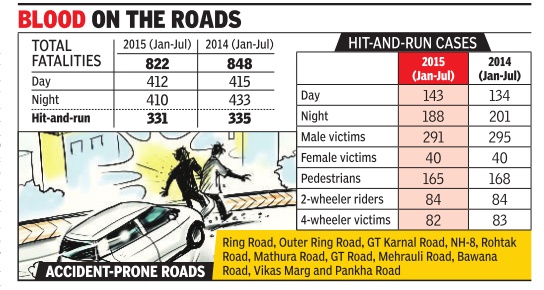
Somreet Bhattacharya
Only 10% solved; poor CCTV coverage and lack of eyewitnesses major impediments
Delhi remains an unsafe city for road users, underlining the urgency in Prime Minister Narendra Modi's expression of concern over the death of 20-year-old Vinay Jindal, a hit-and-run victim who lay bleeding for 10 minutes. Though the traffic police data shows a fall in the number of fatal accidents in the city, the number of hit-andrun cases has not shown any dip since last year. And, shockingly , in only 10% of these cases has the errant driver been traced and booked. Lack of a policy for dealing with such cases strongly is a major impediment in preventing such incidents. This year, out of 822 road fatalities, 331 were cases of hit and run. In the corresponding period last year, 848 incidents had been reported and 335 people had died in hit-and-run incidents. Traffic police officers say they expect the figures to dip following a drive to check the movement of heavy vehicles past midnight.
Experts say though the drives have checked the number of accidents on the highways, roads within colonies are not monitored. For example, Jindal, who was mowed down in Vivek Vihar, was hit as soon as he had driven out of the colony road. Police sources say their plans to monitor these roads using CCTV cameras are still on paper. Though this incident was captured by a CCTV , police could not get a breakthrough due to the quality of the video.
“We have been pushing for technology-based policing at night along with regular pa trols to reduce the number of fatalities. These would include night-vision cameras and speed-checking devices,“ said additional commissioner, traffic, Sharad Aggarwal.
Moreover, it becomes difficult for policemen to find eyewitnesses as people avoid being questioned by the police, fearing harassment. Studies by the traffic police and International Road Federation have shown that in 90% of the cases, the victim dies or turns criti cal as precious moments are wasted in informing the police and ambulance. “People generally avoid contacting the PCR despite assurances they won't be harassed,“ said an official.
In his “Mann Ki Baat“ address, Modi reiterated the need to launch an all-India emergency number,1033, to report such incidents which will be forwarded to the people concerned. It has been observed that a majority of these accidents take place between 9pm and 4am when police presence is limited. Experts blame speed ing, drunk driving and lack of concern for safety of others to be the major reasons for these accidents. Traffic officials say 50% of the casualties involve pedestrians and two-wheelers “In a city like Delhi, some roads are extra wide with fewer number of vehicles. Invariably, motorists tend to overspeed,“ said K K Kapila, IRF chairperson.
Most drivers in the city also do not pay any attention to the high pick-up or weight of their vehicles while driving. “Most drivers speed on a certain stretch and have to slow down suddenly which leads to a pile-up effect,“ an expert pointed out.
The traffic police and ministry of road transport had started a campaign for providing free reflective tapes to cyclists in Delhi and more than three lakh bicycles. Experts say that apart from creating awareness, the government should close loopholes and stiffen penalties in hit-and-run cases.“The requirement is a tougher sentences for those who drive away ,“ said an expert.
2015: Jan-May: dip in heinous crimes
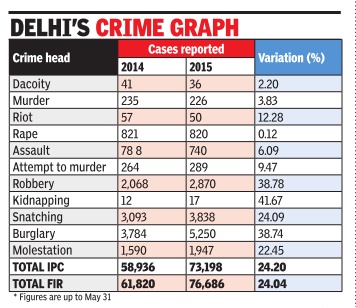
The Times of India, Jun 07 2015
Raj Shekhar
Capital witnesses dip in murders and dacoities
In a shift from the last five years' trend, Delhi has witnessed a dip in heinous crimes this year. Murders, rioting and dacoities--prime indicators of the law and order situation in a city--have plunged in the first five months of 2015. Delhi Police's half-yearly data reveals that murders have dipped by 3.83%. There were 226 murders in 2015 as compared to 235 cases in 2014 in the same period. Cases of rioting and non-communal violence between two groups of people have come down by 12%.
“There were 50 cases reported in 2015 whereas the count in the same time period (January 1-May 31) was 57.Cases of dacoity , too, have come down by 12.2%. There were 41 cases reported last year but the number this year is 36,“ special commissioner (law and order) Deepak Mishra said.
This year, fewer cases of police murders have also been reported. However, scuffles of the general public with policemen have increased this year. Free registration of street crime has led to increase in FIRs filed in cases of snatching and robberies.The snatching cases have ris en from 3,093 to 3,838 while robberies have risen from 2,068 to 2,870. From 12 cases reported till May 31 in 2014, kidnapping cases this year have gone up to 17.
Thefts and burglaries have seen an increase of 38% as police registered 5,250 cases from last year's 3,784 cases. Rape cases have come down by 0.12% as Delhi registered 1 fewer case than last year. This year, 820 cases have been registered till May 31.However, molestation cases have seen an increase from 1,590 to 1,947.
Analysis of heinous crimes suggests that sudden provocation was the leading reason for murders, accounting for about 21% of the killings. About 11% of murders were related to sex, 16% were murdered in enmity while 9% were killed in money-related matters, sources said.Property disputes, police claimed, caused 3% of murders. Crime-related murders were 8% of the total while 10% were due to family disputes. Unidentified dead bodies constituted 10% of the murders. The total number of IPC cases registered till May 31 has shot up from 58,936 to 73,198.
South-west: Land wars

The Times of India, Aug 25 2015
Raj Shekhar
Land at root of SW Delhi's blood-thirst
Gangs across the city have been fighting for supremacy in different lines of business, but it all started in southwest Delhi 20 years ago as two men tried to monopolize land deals Life is cheap in southwest Delhi. As property prices in Najafgarh, Dwarka, Kanjhawala, Narela, etc continue to shoot up, more than a hundred lives have been lost in gang battles for control of the booming real estate market. Police say half of the gang wars in the area have been fought over property disputes and land-grabbing. All the gangs work to a pattern: first occupying a piece of land and then offering to help the owner recover it for a share in the property. This has been going on for almost two decades, but police seem unable to curb the lawlessness in a culture of clans and vendetta.
“This small cluster has defied all norms of public order for more than two decades now.While people in the rest of the city rely on patrol cops and the 100 helpline in crises, here they practise eye-for-an-eye,“ a policeman who has observed southwest Del hi's gang wars over the years said.
Gangs first formed in the area in the early 1990s as a result of the rivalry between two men, Kishan Pehlwan and Balraj. “The tension escalated into a killing spree over issues rooted in land disputes. Even the rivalry between Pehlwan and Balraj arose from a running feud between their families over 12 acres of land,“ a special cell officer said.“Pehlwan, though, changed the rules of the game as his men allegedly killed Balraj, his brother Anoop and others from the rival group in a span of a few years.“
The Balraj gang hit back by killing Pehlwan's uncle Rami and some others. But finally Pehlwan prevailed in southwest Delhi through the 90s and the noughties. The feud between these two families also alienated their villages, Mitraon (Balraj) and Dhichau (Pehlwan).
“In 2007, Pehlwan became even more powerful as his brother Bharat Singh was elected a municipal councillor. Next year, he became an MLA on an INLD ticket,“ the officer said.Pehlwan and his wife Neelam were also elected councillors in 2009 after he got arrested.
But in the years since Pehlwan's rise land had Pehlwan's rise land had become too valuable to be controlled by just one gang.New groups were form ing, and in 2012, the Anoop gang led by Udaiveer alias Kala made an at tempt on Bharat's life. The MLA was wounded but survived. A year later he lost the assembly election setting off the family's decline. The Pehlwan clan was soon reduced to one among many outfits in the Najafgarh area.
From 2013 onwards, the gangs got into the protection business, covering landowners who paid them and attacking those who didn't.There was a spate of killings to settle property disputes. The gangsters demanded a share in the new unauthorized colonies that were coming up.
Gangs led by Naveen Khati, Ravinder Bholu and others along with Manjeet Mahal, Sandeep Men tal and Vikas Langarpuria became active in the area. Older gangsters like Neeraj Bawana, Neetu Dabodia and Manoj Morkheri were already active in the area.
As these gangsters and local politicians declared all-out war to capture the real estate business, the area's villages became a ticking bomb. Four youths were murdered on New Year's Eve in 2014 as a result of the rivalry between the gangs led by Naveen Khati and Ravinder Bholu.Pehlwan's brother Bharat Singh was also bumped off in another attack.For southwest Delhi's new gang order, bloodshed over the most trivial issues is no big deal.
Murders, unsolved
The Times of India Jul 13 2015
Patel Nagar double murder (2010) and Rajouri Garden murder (2011)
On July 9, 2010, Anuradha Nangia (34), wife of a property dealer, and her son Charis (6) were found murdered in West Patel Nagar, central Delhi. Eighteen months later, on January 14, 2012, Gurpreet Kaur (29) and her daughter Jasmin (8), were murdered at their house in Rajouri Garden. The two cases had striking links: all the victims had hair strands either in their hands or lying near them. Charis's elder brother and Jasmin went to the same residential school in Himachal Pradesh. And both sets of murders happened within weeks of the mothers visiting the school. Police have visited the school and got the hair strands tested but the killers remain elusive.
Shobhit Modi murder
The 20-year-old IT student was stabbed to death a few hundred metres from home in Vasant Kunj on May 5, 2011. Interrogation of more than 7,000 people, including ruffians, drug addicts and peddlers, and history-sheeters, besides questioning of 1,200 auto drivers and 1,400 workers at DLF Mall didn't yield clues.Police also analysed 10,000 mobile and landline numbers. Shobhit's family alleged relatives of one of his women friends were involved. Police found them clean.
Rohini triple murder
On September 21, 2012, a couple and their daughter were found murdered inside their Sector 17 house in Rohini. The couple's heads had been smashed but their daughter was smothered with a pillow after suspected rape. She was probably tied up to a window at the time of rape Analyses of phone calls and the family's contacts didn't yield any clues but police haven' given up hope as DNA lifted from teacups found on the dining table--indicating a friendly entry--might eventually lead to the killers.
Sarojini Bartwal murder
The 78-year-old retired journalist was found killed inside her flat on January 10, 2012.She was smothered with a towel. Her son, Hemendra, then an advisor to the British High Commission, lived in Indirapuram, Ghaziabad.More than 200 people, including ragpickers and shopkeepers, were questioned. Police also looked into the property and robbery angles but couldn't crack the case.
GK senior citizen murder
Jogesh, a 66-year-old retired woman journalist, was found strangled inside her GK-I (R block) house in November 2011. She lived with her hus band, a retired government employee, nephew and niece Her room was ransacked, im portant papers were strewn around but neither jewellery nor electronic goods were missing. Enmity or a prop erty dispute was the most plausible theory.
Neha Jindal murder
(2009) 20-year-old DU alumna Neha Jindal's burnt body was found in the backyard of her father's official residence located behind Sarai Rohilla Police Station in North Delhi. Her mother was a Delhi Police sub-inspector. Neha's father Shyam Sunder Jindal, who underwent scientific examination, said he had gone to pick up his wife from Parliament House. On returning, he claimed, he found the front door open and the house ransacked, although police didn't buy this. Burnt bits of paper were found near the body . Police examined suicide and murder angles but couldn't make a breakthrough.
Chhitarmal Jain murder
Chhitarmal Jain (50), owner of Deluxe Store in Defence Colony Market, didn't return home on the night of October 26, 2012. His body was found next morning in Delhi Cantonment but his Hyundai Accent car was in the VIP parking at AIIMS. His phone was traced to a labourer in Madhya Pradesh who claimed to have found it at Sarai Kale Khan ISBT. There were two initial suspects: a 20-year-old who had met Jain and started working for him a month ago and his friend who worked with an NGO. Both were found innocent eventually and the case was buried.
Valentine's Day murder
Simranjeet Kaur (26), a married woman who worked as HR manager with a Noida MNC, was killed at 7.36 pm on February 14, 2014 in a Karol Bagh neighbourhood.The killer stabbed her in the heart with a kitchen knife just outside the house of her cousin whom she wanted to surprise with a visit. Kaur was heard shouting “chor, chor“ and CCTV cameras of nearby houses showed a young man wearing dark jeans and white jacket trail her, stab and flee. Police see it as a rob bery gone wrong. They drew up a list of 70 suspects, of whom 60 were de clared clean and the rest went untraced.
Cash van heists in 2013, 2014
On October 27, 2013 bikers in two pairs snatched Rs 90 lakh at gunpoint from a cash van in northeast Delhi. On November 30, 2014, two armed robbers on a bike shot dead a cash van guard and looted Rs 1.5 crore from staff loading cash in a Citibank ATM in Kamla Nagar, north Delhi. Neither group of robbers has been identified. In the Kamla Nagar case, 26 ex-employees of the cash replenishment company who were either sacked or quit were verified and found clean.
2015
Road accidents in Delhi
The Times of India Jan 05 2016
Somreet Bhattacharya
The vehicle count increased, but 2015 was the safest year in a decade in terms of traffic fatalities.There were 1,496 deaths in 1,532 accidents, as against 1,575 in 1,616 accidents a year ago. Police said strict enforcement of rules, including cancellation of licences, brought about the improvement, but data shows a 14% decrease in challans--from 42 lakh in 2014 to 36 lakh in 2015.
The eChallan system enabled police to identify repeat offenders, and more than 19,000 licences were seized in special drives recommended by the Supreme Court committee on road safety.In one of these `Chakravyuh' drives, more than 1,000 vehicles were challaned in a day.
Analyses of the accidents in 2014 helped police remove some of the causes. Road-owning agencies were asked to make changes on 137 accident-prone stretches.
Worryingly, the number of challans for drunk driving decreased by 11% from 2014; there were 24,960 chal lans till December 15 last year, as against 28,059 in 2014.While 707 licences were cancelled, 3,529 drunk drivers were sent to jail for 1-3 days, 21 for 4-5 days, seven for 6-9 days and six for 10 days. Another 38,224 reckless drivers were counselled on safe dri ving.
Police involved people in traffic policing through phone apps and their Facebook page, and 5,200 violations were reported by the public. Hired helicopters were also used for regulating and monitoring traffic movement during festivals in 2015.
Crimes against women
The Times of India Jan 05 2016
Somreet Bhattacharya & Anvit Srivastava
TNN
The capital saw a rise in crime against women in 2015 compared to the previous year. While 5,192 cases of molestation of women were reported last year, the number was 4,322 in 2014.
However, most cases were solved well in time. More than 70% of the crimes against women were worked out and chargesheeted within the fortnight of reporting the incident, police claimed.
In 2015, the number of rape cases reported was 2,095 as against 2,085 in 2014. Of the 2,095 cases, 1,715 were solved.In the data published by Delhi Police, 2,024 rapes were committed by the family members or people known to the victim, and 71accused were strangers. An analysis of the data showed that 50% of the victims were aged between 18 to 25 years.
According to the analysis, of the 2,095 rape accused, 911 studied till Class X and were between the age group of 18 to 25 years; 1,195 were from a poor economic background. A total of 86.73% of the rapes took place in houses or at slum clusters, and 3.29% at hotels and restaurants.
Of the total 5,192 molestation cases, 838 were solved.Police said 460 cases were solved within a week of registration of the FIR. According to the records, 39.25% molestation occurred on roads, while nearly an equal number at houses.
Delhi Police conducted gender sensitisation programmes in 2015 under which 11,130 boys were sensitised. It also held several selfdefence programmes for women at schools and colleges across the city . Besides, an operation to identify sexual offenders on roads and bus stops was also conducted under Operation Shishtachar.Women police officers in civvies were posted at busy vulnerable places.
Delhi Police also launched Himmat app in February last year using which the victims could make SOS calls to alert police.
Heinous crimes
The Times of India Jan 05 2016
Anvit Srivastava
With 1,82,644 FIRs in 2015, as against 1,47,237 in 2014, Delhi last year witnessed a 24.05% increase in heinous crimes like robberies, rapes, attempt to murders and break-ins. Police record showed that 49,892 cases were solved.
Police attributed the increase in the number of cases to the “truthful registration“ of crime. A total of 7,192 cases of robbery , 541 cases of murder, 750 cases of attempt to murder, 73 cases of dacoity, 2,095 cases of rape, and 36 cases of kidnapping for ransom were reported last year. Police solved 3,367 robbery , 64 dacoity, and 415 murder cases.However, some of the grueso me cases, including the murder of two women whose bodies were found in northeast Delhi, remained unsolved.
An analysis of the motives behind the murders throughout the year showed that 16.64% of the cases were due to sudden provocation or trivial issues, 18.67% due to old enmity, 9.61% related to sexual indulgences, 13.49% due to differences among family members, and 9.61% as a result of disputes over property and money . Only 9.43% of the murders were crime related.
According to the record, 41% of the murders were committed using sharp-edged weapons, while in 18% of the cases, blunt objects were used.Strangling was recorded in 16% of the total murders, and in 13%, firearms were used.
Crime inside buses
2015: CCTVs bring down crime
The Times of India, Mar 10 2016
Rumu Banerjee
CCTVs in DTC buses bring down crime graph
After a failed GPS experiment, technology finally seems to be working for the Delhi Transport Corporation (DTC). A pilot project of installing CCTV cameras in 200 buses has not only resulted in improvement of staff behaviour, but even general security . “Two depots -Sarojini Nagar and Rajghat -were part of the experiment.Both have reported an improvement in the efficiency of the staff as well as a drop in the number of crimes, like pick-pocketing,“ said RS Minhas, the DTC spokesperson.
The report has been compiled from the time the CCTV cameras were installed in the DTC buses. Minhas said the first camera was installed in November 2014. “Since then, 200 buses have been fitted with the CCTVs. We plan to install it in all buses over the next few months,“ he added.
From schoolchildren fighting inside the bus to incidents of mobile theft and pick-pocketing, all the recordings have been kept or handed over to Delhi Police.The report shows that the first incident recorded was of a cellphone theft in No vember 2014, followed by a fight between schoolchildren in December.
Disputes between passengers, against the conductor or driver, as well as accidents with other vehicles have been recorded and resolved as per the CCTV recordings, says the report.“Even incidents of tyre bursting or windows being broken have been recor ded,“ said Minhas.
The project has had a positive impact on operations.“Efficiency has gone up, schedules are being kept, buses get parked in the right slots in depots and behaviour of staff has improved. Even passengers are well-behaved as they know about the CCTVs,“ he added.
The biggest achievement, perhaps, is that the CCTV cameras have not been removed or stolen like the GPS devices that were installed on DTC buses a few years ago.
